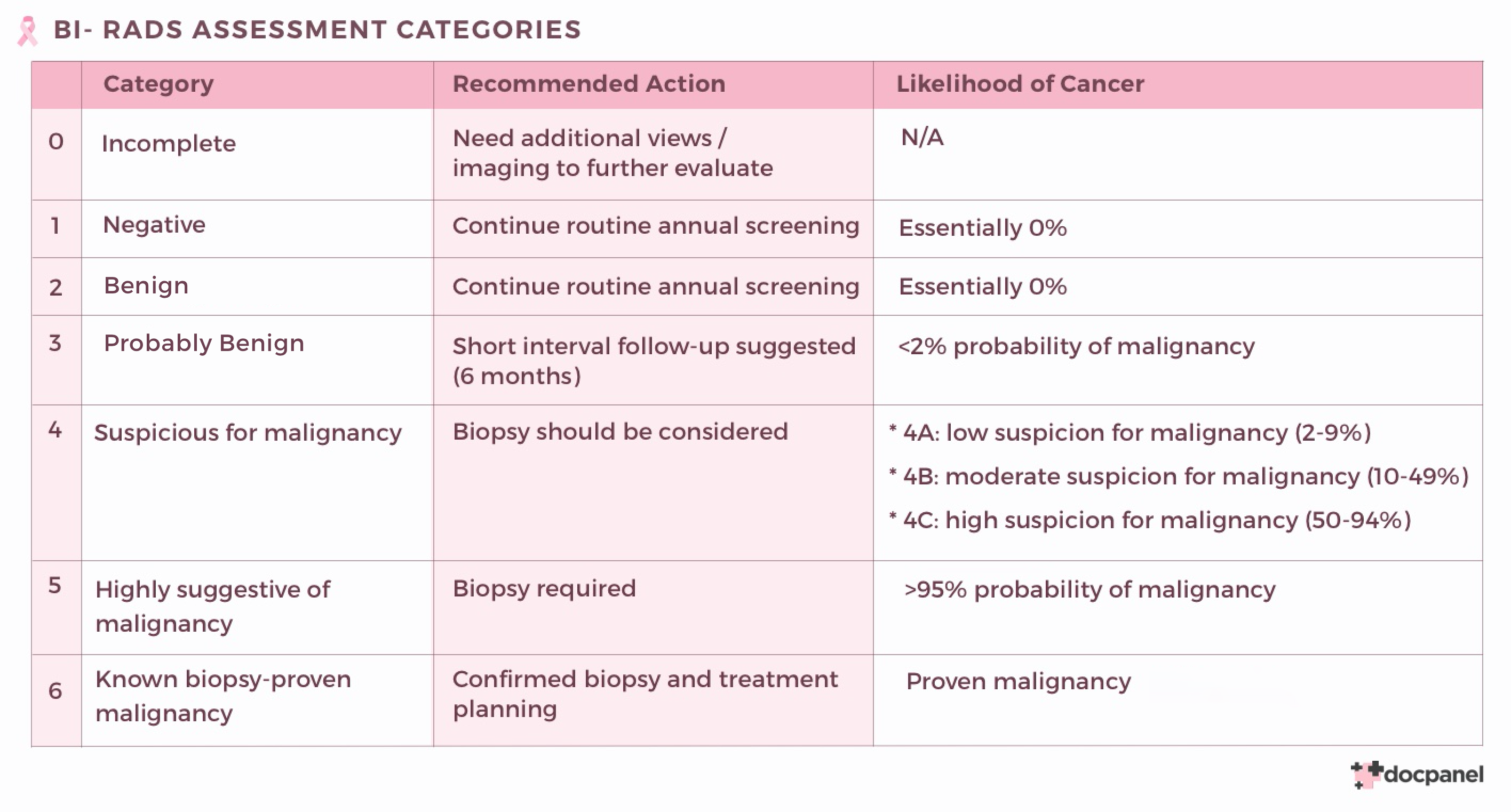For many women, mammograms can be stressful. The associated discomfort. The nerve-racking days spent waiting for your results. They are far from fun. So when you finally get your report, you want to make sure you understand it.
To demystify BIRADS, we spoke with Dr. David Cline, a Mayo Clinic trained breast imager and Assistant Professor of Radiology at the Naval Medical Center in San Diego. From how to interpret each score to their associated recommended next steps, here is your guide to navigating BIRADS.
What are BIRADS?
BIRADS is a numerical scoring system used to evaluate the risk of breast cancer based on a mammogram, breast ultrasound, or breast magnetic resonance imaging (MRI) report. Each report is given a score, ranging between 0 and 6, that helps radiologists communicate if anything in an image looks abnormal and, if so, how concerning the finding is to them.
But if you are not a pathologist or a physician, BIRADS can leave you feelig confused and stressed. The process, however, is intended to provide clarity. If you are feeling confused or worried about the score indicated on your radiology report, getting a second opinion from a breast imaging subspecialist can help:
- Ensure accuracy
- Provide confrimation before getting a biopsy
- Give you an opportunity to ask questions
- Provide peace of mind
Learn more about how to get a second opinion on your breast imaging exam here.
[DocPanel] Why were BIRADS created? What role do they play for a patient?
[Dr. Cline]
BIRADS (Breast Imaging-Reporting and Data System) is a medical scoring system designed to ensure mammograms are reported clearly and uniformly. Each score has a meaning, and a specific required action.
The right action must be applied to each situation and image finding. An image finding in one situation may mean something different in another situation. BIRADS Scores help ensure this by directing patients, radiologists, and physicians to the appropriate actions.
So, for a patient, their BIRADS score is there to help let them know what they need to do next. It allows for easy tracking and follow-ups, so patients get what they need when they need it. For example, a BIRADS 0, which is quite common, means that for some reason, the images gathered weren’t enough, or that the breast images were unclear. In that case, the patient needs to go back to get additional imaging.
Check out our blog post on Understanding Mammogram Callbacks.
What does each BIRAD score indicate?
[DocPanel] Are there any BIRAD scores that require no action?
[Dr. Cline]
Well, technically, no. Even if your scans come back perfect, the action necessary is to return next year for your annual checkup. For that particular screening, however, BIRADS 1 negative and BIRADS 2 benign mean you have nothing to worry about – everything is fine, based on that screening.
Learn more about how to get a second opinion on your breast imaging exam here.
[DocPanel] BIRADS 3 (probably benign) asks patients to follow up in 6 months. This can be quite scary and nerve-racking for a patient. How should they interpret this score?
[Dr. Cline]
What patients should know and understand is that the person assigning a BIRADS 3 is suggesting a very very low likelihood that what we’re following is cancer.
When assigning this score, we use the number of less than 5% likelihood that the ‘abnormality’ is going to be a problem. So people can take comfort in realizing that the radiologist really does not think it’s a problem.
If the radiologist thought it was a problem, they’d make it a BIRADS 4 and biopsy it. But all that is not conveyed just by hearing ‘ your BIRADS 3 come back in 6 months’. The likelihood that you have cancer is very low.
[DocPanel] A BIRADS 4 indicates a suspicious finding with a 2-94% probability of malignancy. That’s a broad range. What advice would you give a patient with this score?
[Dr. Cline]
A BIRADS 4 can mean two things. The radiologist may be concerned that an abnormality is cancerous. Or a patient may be worried about an abnormality and want a biopsy.
Let’s look at the first scenario. Say a patient, Michelle, has an abnormal finding on her mammogram. If I feel that there is a chance it could be cancer, I’ll assign a BIRADS 4. This indicates that the abnormality should be biopsied and sent to pathology. It can be challenging to discern whether it’s benign or malignant in an image. The only way to know is to do a biopsy. So when we say BIRADS 4 – it’s essential that the patient follows through with a biopsy.
Now let’s look at the second scenario. Sally, a young woman, comes in for a checkup after feeling a lump in her breast. After performing a mammogram and reading her report, I diagnose the lump as a benign fibroadenoma and let her know there’s no need to do a biopsy. In this case, I would put her at a ‘BIRADS 3, suggesting follow-up for two years.’
But, after telling Sally my interpretation, she may still want a biopsy. In that case, I would give her report a ‘BIRADS 4 follow up in 6 months recommended, but the patient desires pathological evaluation. Therefore a biopsy is being pursued.’
So in some cases, a BIRADS 4 is driven by the radiologist’s concern. In others, by the patient’s anxiety and desire to get peace of mind.
CONNECT WITH A SPECIALIST
Get a Second Opinion
Take charge of your health with an online second opinion from a radiology specialist.
[DocPanel] What factors influence the accuracy of a BIRAD score? Do things like equipment, technique, or documentation ever cause errors? If so, how can they be avoided?
[Dr. Cline]
The FDA strictly controls many factors regarding breast imaging to eliminate variability. These factors range from image acquisition to radiologist interpretations. It mandates equipment quality, regular equipment testing, proper training of technologists and radiologists, to help minimize errors.
All clinics have to go through an annual inspection from the FDA, called an MQSA inspection. So long as they’re passing their inspection, they should be following all the rules.
Accreditation is the one thing patients should also check for at an imaging center. If they’re not accredited, which is against the law, they may not be following all the rules.
[DocPanel] What are the 3 most common questions patients ask you about breast imaging?
[Dr. Cline]
-
Q. Can I do an ultrasound only, instead of a mammogram? Is that adequate screening?
A. No. You don’t see calcifications on ultrasound the way you see them on a mammogram. And calcification can be an indication of early-stage cancer. -
Q. What do I do if I have dense breasts?
A. Current practice is to offer a second type of exam, most commonly breast ultrasound, in addition to mammography for patients with dense breasts. This helps ensure any small treatable abnormalities that would otherwise be obscured on a mammogram alone are found and addressed. -
Why can’t I just have an MRI?
A. MRI is not indicated for screening unless a woman is high-risk. It’s used more for diagnostic imaging – when cancer has been found.
[DocPanel] What inspires you to dedicate your life to the cause of breast imaging and cancer detection?
[Dr. Cline]
Realizing that 1 in 8 women get breast cancer. Working in this field as a breast radiologist allows me to apply years of training to help find problems early and save lives. That is what inspires me.
BIRADS are not definitive. They’re intended to report findings, guide actions, and are designed with the intent to change as the case unfolds. They help strengthen communication between patients, radiologists, and physicians – which helps improve patient outcomes.
If you have questions about your report – talk to your doctor. Speak to the radiologist who did your report. And if you feel uneasy, get a second opinion through DocPanel. This will allow you to ask the radiologist specific questions and get a second interpretation.


